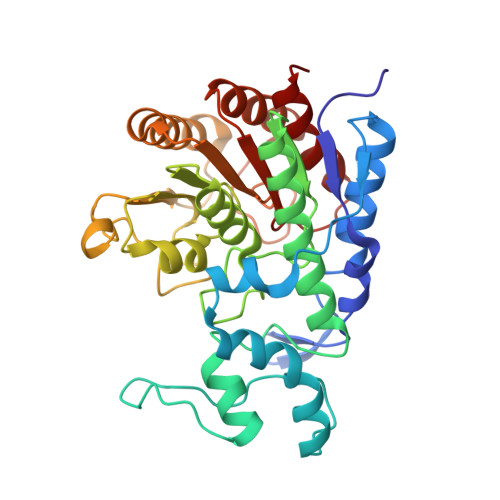Structure and Function of the Acetylpolyamine Amidohydrolase from the Deep Earth HalophileMarinobacter subterrani.
Osko, J.D., Roose, B.W., Shinsky, S.A., Christianson, D.W.(2019) Biochemistry 58: 3755-3766
- PubMed: 31436969
- DOI: https://doi.org/10.1021/acs.biochem.9b00582
- Primary Citation of Related Structures:
6PHR, 6PHT, 6PHZ, 6PI1, 6PI8, 6PIA, 6PIC, 6PID - PubMed Abstract:
Polyamines are small organic cations that are essential for cellular function in all kingdoms of life. Polyamine metabolism is regulated by enzyme-catalyzed acetylation-deacetylation cycles in a fashion similar to the epigenetic regulation of histone function in eukaryotes. Bacterial polyamine deacetylases are particularly intriguing, because these enzymes share the fold and function of eukaryotic histone deacetylases. Recently, acetylpolyamine amidohydrolase from the deep earth halophile Marinobacter subterrani (msAPAH) was described. This Zn 2+ -dependent deacetylase shares 53% amino acid sequence identity with the acetylpolyamine amidohydrolase from Mycoplana ramosa (mrAPAH) and 22% amino acid sequence identity with the catalytic domain of histone deacetylase 10 from Danio rerio (zebrafish; zHDAC10), the eukaryotic polyamine deacetylase. The X-ray crystal structure of msAPAH, determined in complexes with seven different inhibitors as well as the acetate coproduct, shows how the chemical strategy of Zn 2+ -dependent amide hydrolysis and the catalytic specificity for cationic polyamine substrates is conserved in a subterranean halophile. Structural comparisons with mrAPAH reveal that an array of aspartate and glutamate residues unique to msAPAH enable the binding of one or more Mg 2+ ions in the active site and elsewhere on the protein surface. Notwithstanding these differences, activity assays with a panel of acetylpolyamine and acetyllysine substrates confirm that msAPAH is a broad-specificity polyamine deacetylase, much like mrAPAH. The broad substrate specificity contrasts with the narrow substrate specificity of zHDAC10, which is highly specific for N 8 -acetylspermidine hydrolysis. Notably, quaternary structural features govern the substrate specificity of msAPAH and mrAPAH, whereas tertiary structural features govern the substrate specificity of zHDAC10.
Organizational Affiliation:
Roy and Diana Vagelos Laboratories, Department of Chemistry , University of Pennsylvania , 231 South 34th Street , Philadelphia , Pennsylvania 19104-6323 , United States.


















